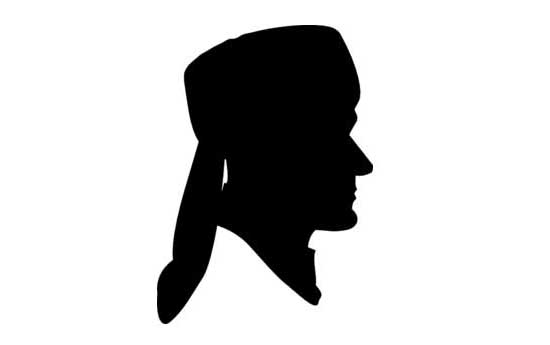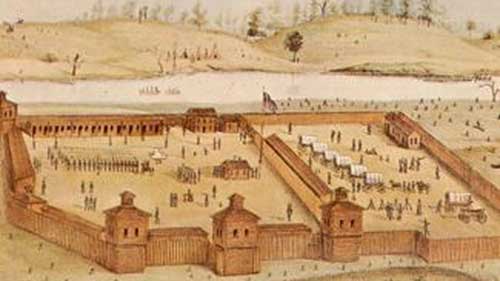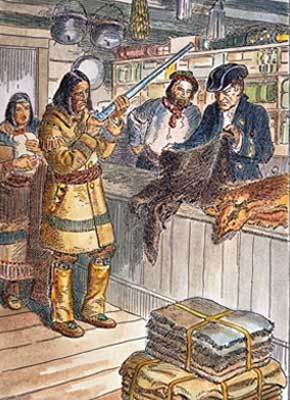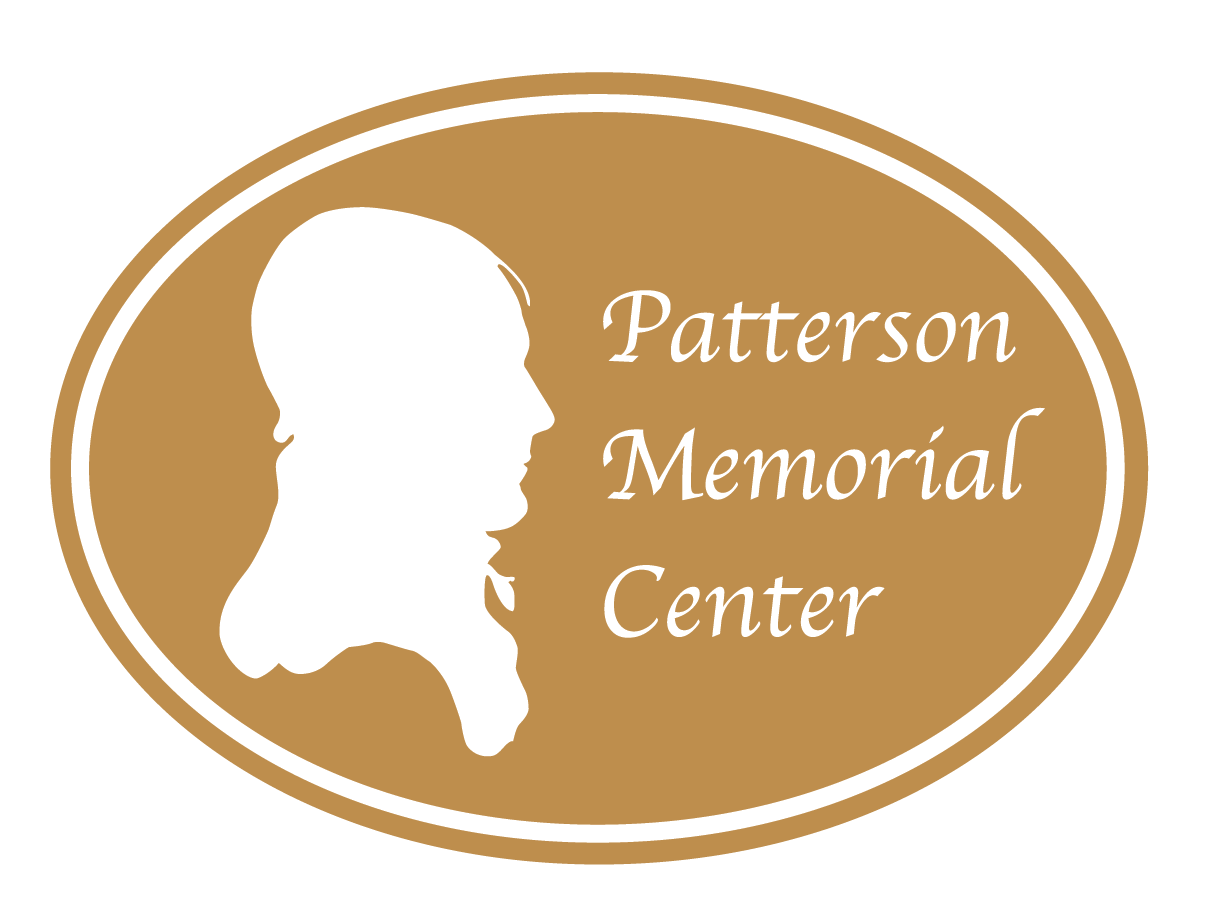
Henry Brown was born near Wood's Creek (now Lexington), Virginia, on May 8, 1772, to Abraham and Margaret Kirkham Brown. He was the seventh of ten children.
Henry's parents, who were of Scotch-Irish descent, grew up on adjacent farms. His Presbyterian parents had him baptized in the Old Stone Church on Whistle Creek, near the graves of his immigrant grandparents.
LINK TO ENDNOTE: What is a Presbyterian?
Abraham and Margaret sold their farm in 1773, and moved to the west bank of the New River; today this is Belspring, Virginia.
Move to the Northwest Territory
In 1793, Henry moved to the Northwest Territory as military secretary to Colonel John Preston. Preston commanded a regiment under General Anthony Wayne. Wayne was in Cincinnati preparing to confront the Native Americans conducting raids on territorial settlers.
LINK TO ENDNOTE: What was the Northwest Territory?
Wayne's mission was to defeat the Northwest Indian Confederation to allow white settlement in the territory, which included the Ohio Country. The Battle of Fallen Timbers was fought on August 20, 1794, which led to the Treaty of Greenville on August 3, 1795. With this treaty, the Native Americans ceded most of the land that would become the state of Ohio in 1803.
LINK TO ENDNOTE: What Native-American tribes comprised the Northwest Indian Confederation?
Henry also provided supplies to the army garrisons at Fort Hamilton, Fort St. Clair, Fort Greenville, Fort Jefferson, Fort Recovery, and Fort Defiance, all in present-day Ohio, and Fort Wayne in present-day Indiana.
Because of the rough condition of the roads and the danger from Native-American attacks, all supplies were loaded on pack-horses which were divided into "brigades." Henry worked in these brigades until 1795.
Trade with the Native Americans
Following the Treaty of Greenville, which resulted in peace with the Native Americans, Henry began a partnership with John Sutherland. They opened a trading post at Fort Hamilton, about 20 miles north of Cincinnati. The firm, Sutherland and Brown, intended to trade with the Native Americans and opened its first store in a double-log cabin located south of the fort.

Friendly native tribes, primarily the Miami, occupied most of the country west of Wayne's Road. Their camps were found along the streams from Fort Hamilton north to the Wabash and Maumee Rivers.
LINK TO ENDNOTE: What was Wayne's Road?
Sutherland and Brown traded goods with the natives for furs and pelts, which were used to trim clothing, and make hats and coats. The demand for furs in Europe was especially great among the aristocracy.
LINK TO ENDNOTE: What goods were traded with the Native Americans?
As white settlers moved to southwest Ohio in greater numbers, the Native Americans moved northward and westward, away from them. Sutherland and Brown followed the natives with agents who carried the trade-goods from location to location on pack-horses.
Trading Post in Dayton
Before settlers arrived in Dayton, Henry operated a small trading-post at the confluence of the Mad and Miami Rivers, just downstream from its junction with the Stillwater River (now under the west-end of the Interstate-75 Bridge).

With business increasing, Henry opened a larger store in Dayton in 1804 that served as his base of operations. It was located on the east side of Main Street, south of the riverfront on Water Street (now Monument Avenue). Henry's store was the first dedicated to selling merchandise.
From Dayton, Henry sent traders with trade-goods to settlers in the west and north, and to the native villages at Greenville and Wapakoneta, both in Ohio, and Fort Wayne, in Indiana, and through the Maumee River Valley that flows from northeastern Indiana into northwestern Ohio and Lake Erie.
A trader would often be gone several months with two or more pack-horses loaded with trade-goods; they returned with pelts and furs. Typically, these came from beaver, muskrat, fox, raccoon, bear, and deer.
Pioneers often brought cattle and hogs with them from the East. Initially, they served the dietary needs of the settlers. Eventually, as the livestock was bred, excess livestock could be sold for cash. By the mid-1790s, livestock sales became an important part of the Ohio frontier economy.
Sutherland and Brown purchased cattle raised in the Miami Valley and Kentucky intended for slaughter. The cattle were driven north to Detroit, where they were sold to the government, Native Americans, and farmers.
Building close to a river, such as the Great Miami, was common as it was the main, sometimes only, transportation route. However, there was always the danger of flooding. Wise builders attempted to avoid this by building their homes and stores several feet above street level.
Henry built Dayton's first brick residence in 1808 on the west side of Main Street, north of the court house (now the site of Key Bank on Courthouse Square). It was a two-story dwelling built 3 feet above street-level for protection against high water. When he married Catherine "Kitty" Patterson, Henry refurnished his brick house, and built a new smokehouse, cellar, and kitchen.

As Henry traveled by horse much of the time, he usually wore "short clothes," that is, a hunting shirt or jacket, knee-breeches and buckles, cap, stockings, and moccasins.
However, when he was courting Kitty Patterson or for Sunday, Henry wore an open jacket or cloth coat, vest, ruffled shirt with a high collar, brass buttons on his coat and vest, buckles to fasten his breeches and stockings at the knee, buckles on his shoes, and a beaver hat.
LINK TO ENDNOTE: What does courting mean?
Henry and Kitty became engaged in 1810. Henry likely knew Kitty earlier as both Henry and the Patterson family moved to Dayton in 1804. However, the attraction between them did not develop until 1809 or 1810, according to a letter Kitty wrote.
Henry likely wore his best clothes when he married Kitty in her wedding dress of Quaker-gray silk on February 19, 1811. They were married in the Patterson log house on the Rubicon Farm. The Rev. James Welch of the First Presbyterian Church officiated.
Henry and Kitty had five children, three of whom lived to adulthood.
LINK TO ENDNOTE: Who were the Brown children?
LINK TO ENDNOTE: Read about the marriages of the Brown children!
Although the Revolutionary War ended in 1783 with the Treaty of Paris, the British maintained a presence around the Great Lakes as they still controlled Canada.
The British supported the various Native-American tribes who lived there and promised to support their efforts to curb the influx of white settlers.
In 1810, the rapid influx of white settlers into Ohio resulted in increased hostilities with the Native Americans.
As the danger to traders increased, Sutherland and Brown withdrew their agents, and dissolved their partnership in June 1812. Henry then moved his inventory of goods to the north room of his and Kitty's residence, and continued business there.
With the War of 1812, Henry became a government agent in charge of Indian supplies. He worked under the direction of the Indian Agent for the Shawnee (later, Agent for all Ohio Indians), Colonel John Johnston in Piqua.
Henry also worked with Colonel Robert Patterson supplying the U.S. Army. They had a large log warehouse filled with goods on the backside of a lot on the southwest corner of Third and Main Streets (now where the 5/3 Bank Tower is located). While Robert usually handled the administrative side as quartermaster, Henry often accompanied the goods to their various destinations.
Kitty contributed to the war effort, as well, by joining her mother, Elizabeth Lindsay Patterson, and women across Montgomery County in making clothing for the American soldiers.
The women were able to produce 1,800 hand-sewn shirts within a month. They also made clothes for the soldiers' families. The clothing was distributed via the supply routes established under Robert Patterson as quartermaster for Ohio.
After the war, Henry continued to prosper as a merchant and, like Robert Patterson, promoted the general welfare of Dayton through improved transportation. He supported the opening of roads to all neighboring settlements, a main roadway between Dayton and Cincinnati, and a canal that would connect Dayton with markets in the East.
In 1813, the increase of business made it desirable to establish a bank. Henry aided in the organization of the Dayton Manufacturing Company, Dayton's first bank. He also secured a considerable loan for the new bank from the United States Bank.
Henry Brown died following a lingering illness on May 19, 1823. He was originally buried in the old graveyard on Fifth Street and later moved to the Brown Vault in Woodland Cemetery in Dayton on October 5, 1848.

Following Henry's death, Kitty married Andrew Irwin in 1826 and they would have one son, Andrew Barr Irwin. Andrew Irwin died in 1827, leaving Kitty a widow for a second time.
In 1836, Kitty married Horatio Gates Phillips; they had no children. However, both were involved with many charities and recognized for this with the naming of the Phillips House Hotel in their honor. Horatio died in 1859. For the third time, Kitty was a widow.
Catherine "Kitty" Patterson Brown Irwin Phillips died August 12, 1864, in Dayton, and is buried in the Brown family vault in Woodland Cemetery with her first two husbands, Henry Brown and Andrew Irwin.
ENDNOTE - What is a Presbyterian?
The Presbyterian Church is a denomination within the Protestant or Reformed tradition of Christianity. It traces its origins to John Knox and the Church of Scotland. Presbyterian churches derive their name from the form of church government which is by a representative assembly of elders, known as a presbytery.
ENDNOTE - What was the Northwest Territory?
The U.S. Congress established the Northwest Territory in 1787 that included land west of Pennsylvania, north of the Ohio River, east of the Mississippi River, and south of the Great Lakes. The Native Americans, French, and British all claimed this land at some point, with the British holding the land at the beginning of the American Revolution. The British ceded the land to the United States at the Treaty of Paris that ended the American Revolutionary War. However, the Native Americans did not relinquish their claim to this land until the Treaty of Greenville (1795), which followed the Battle of Fallen Timbers (1794) where the natives were defeated. The Northwest Territory, once settled, would include Ohio, Indiana, Illinois, Michigan, and Wisconsin.
ENDNOTE - What Native-American tribes comprised the Northwest Indian Confederation?
The Northwest Indian Confederation was a loose organization of mostly Great Lake Native-American tribes formed at the end of the American Revolution to prevent expansion of white settlement in the Northwest Territory. This territory was ceded by the British to the United States in the 1783 Treaty of Paris that ended the American Revolutionary War. The participating tribes included:
ENDNOTE - What was Wayne's Road?
In anticipation of attacking the Native-American tribes in western Ohio, forces under General Anthony Wayne in 1793 began cutting underbrush and felling trees to create a road that would allow his soldiers, wagons, and artillery to move along. This road began at Cincinnati (Fort Washington) and ran northward, connecting existing forts, such as Forts Hamilton and Jefferson, with new ones that Wayne created, such as Forts Greenville, Recovery, and Defiance.
ENDNOTE - What goods were traded with the American Natives?
Trade goods included kettles, blankets, cloth, axes, knifes, steel traps, and tobacco. Even firearms and alcohol were traded.
ENDNOTE - What does courting mean?
Courting is a term used to describe a romantic relationship between a man and a woman with the intent of marriage. It is similar to dating, but specifically, with marriage as the goal.
ENDNOTE - Who were the Brown children?
Henry and Kitty Brown had five children, three of whom lived to adulthood. They were:
ENDNOTE - Read about the marriages of the Brown children!
All three of Henry and Kitty's surviving children married:
A History of Montgomery County, Ohio. (1882). Chicago: W. H. Beers.
The Holy Bible: Containing the Old and New Testaments. (1853). Philadelphia: E. H. Butler & Co. [Henry L. Brown Family Bible].
Centenary Souvenir: Commemorative of the Completion of a Century by the First Presbyterian Church of Dayton, Ohio. (1900). Dayton, OH: United Brethren Publishing House.
Conover, C. R. (1902). Concerning the Forefathers: Being a Memoir, with Personal Narrative and Letters of Two Pioneers, Col Robert Patterson and Col John Johnston. New York: Winthrop Press.
Conover, C. R. (1932). Dayton, Ohio: An Intimate History. Landfall Press: Dayton, OH.
Edgar, J. F. (1896/2008). Pioneer Life in Dayton [Ohio] & Vicinity, 1796 — 1840. Westminster, MD: Heritage Books.
Keifer, J. W. (2004). Civil War Regiments from Ohio. eBooksOnDisk.com [Originally published by the Federal Publishing Company]
Knepper, G. W. (1989). Ohio and its People. Kent, OH: The Kent State University Press.

Do you have photos, books or other information that you believe may be pertinent to this website?
Are you interested in contributing to our organization?
